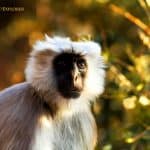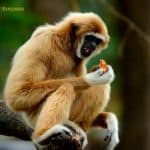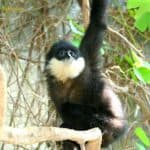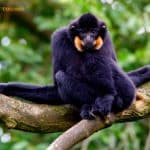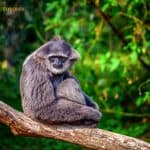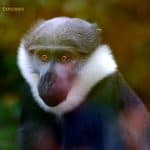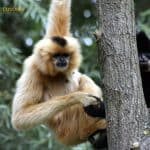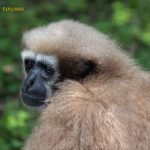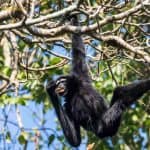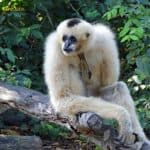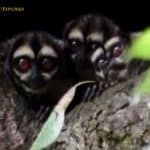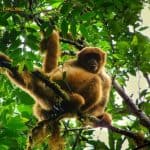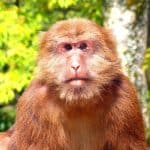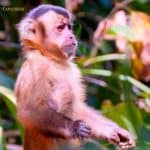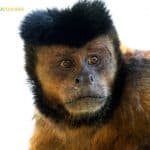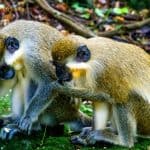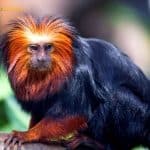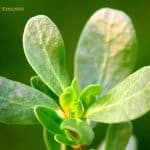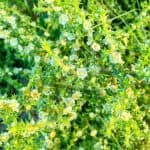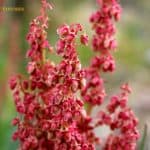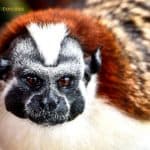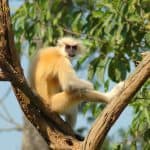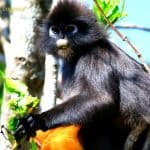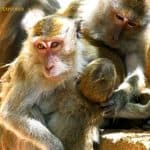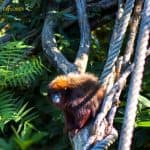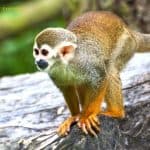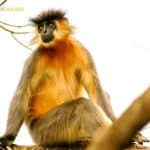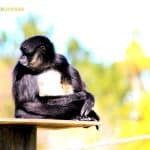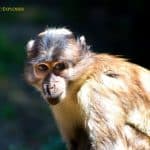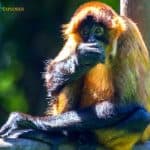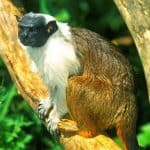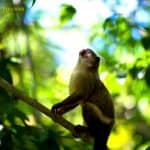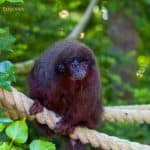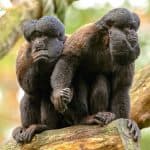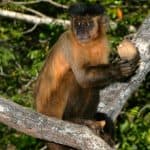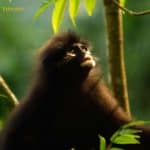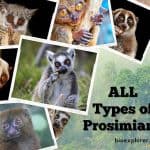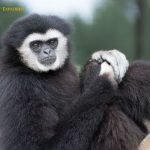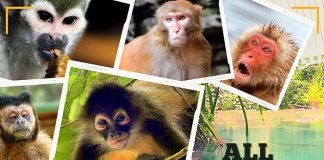top - search results
If you're not happy with the results, please do another search
White-headed Langur
The white-headed langur (Trachypithecus leucocephalus) is an endangered species of langur native to Guangxi, China. As the common name suggests, a tuft of white fur covers this primate's head.
Tarai Gray Langur
The Tarai gray langur (Semnopithecus hector) is an Old-World monkey and was once thought to be a subspecies of the northern plains gray langur. The Latin name for Tarai gray langurs is inspired by Hector, the prince of Troy.
Phayre’s Langur
Phayre's leaf monkey (Trachypithecus phayrei), also called the Phayre's langur, is a species of Lutung endemic to South and Southeast Asia. The name commemorates the late Sir Arthur Purves Phayre, a lieutenant general in the British Indian Army and commissioner of the entire province of former British Burma.
Lar Gibbon
The lar gibbon (Hylobates lar), also called the white-handed gibbon, is another endangered mammal in the gibbon family, Hylobatidae. It is among the best-known gibbons and is occasionally kept in captivity. Lar gibbons have a two-tone coat.
Southern White-Cheeked Gibbon
The southern white-cheeked gibbon (Nomascus siki) is a species of gibbon endemic to Laos and Vietnam. It is closely related to the yellow-cheeked gibbon (Nomascus gabriellae) and northern white-cheeked gibbon (Nomascus leucogenys).
Siamang Gibbon
The siamang gibbon (Symphalangus syndactylus) is a black-coated arboreal gibbon endemic to the forests of Thailand, Malaysia, and Indonesia. It is the only species in the genus Symphalangus. The siamang's body is perfectly adapted to a life of swinging from branch to branch (also called brachiation).
Northern Buffed-Cheeked Gibbon
The northern buffed-cheeked gibbon (Nomascus annamensis) is a species of crested gibbon recently discovered in Vietnam, Laos, and Cambodia. Northern buffed-cheeked gibbons live almost exclusively in trees and rarely leave the canopy's comfort and safety.
Silvery Gibbon
The silvery gibbon (Hylobates moloch), also called the Javan gibbon, is a primate in the gibbon family, Hylobatidae. Silvery gibbons are tree dwellers and feel just as comfortable in the upper canopy as in the undergrowth.
L’hoest Monkey
The L'Hoest monkey (Allocrocebus lhoesti), or mountain monkey, is a vervet monkey found in the upper eastern Congo Basin. L'Hoest monkeys live in relatively small groups, are dominated by females, and have only one male.
Kloss’s Gibbon
Kloss's gibbon (Hylobates klossii), also called the dwarf siamang, Mentawai gibbon, or Bilou, is an endangered primate in the gibbon family Hylobatidae. Kloss's gibbons are territorial, with semi-adult males and adolescents working with their fathers to protect the group's territory.
Hainan Black-Crested Gibbon
The Hainan black-crested gibbon (Nomascus hainanus), also known as Hainan gibbon, is an endangered species of gibbon only found on China's Hainan Island. Hainan black-crested gibbons are found in social groups of females, infants, juveniles, and sometimes males.
Skywalker Hoolock Gibbon
Skywalker's hoolock gibbon, also known as the Gaoligong hoolock gibbon, is a primate of the Hylobatidae family. The Skywalker hoolock gibbon is one of 3 species of hoolock gibbons and was first described in the American Journal of Primatology in January 2017.
Eastern Hoolock Gibbon
The eastern hoolock gibbon is a primate of the Hylobatidae family. Eastern hoolock gibbons don't have a tail like all other apes but have a patch of hair in the anogenital region.
Black-Crested Gibbon
Black-crested Gibbons are mainly found in southern China (Yunnan) and some distribution areas in northwestern Laos and northern Vietnam. Black-crested gibbons exhibit sexual dichromatism, with the male being entirely black, while the female is yellowish or tan in color with variable black markings.
Spix’s Night Monkey
The Spix's night monkey (Aotus vociferans), also called the Spix's owl monkey, Colombian gray nocturnal monkey, and noisy night monkey is a species of night monkey native to South America.
Southern Muriqui
The southern muriqui or woolly spider monkeys (Brachyteles arachnoides) are scattered across southeastern Brazil, from Bahia north to Sao Palo south. The southern muriqui is one of the largest primates in South America, with males weighing around 15 kg and females around 12 kg.
Tibetan Macaque
The Tibetan macaque (Macaca thibetana), also called the Chinese stump-tailed macaque is a macaque native to eastern Tibet, eastern Guangdong, and northern Shaanxi in China. Tibetan macaques are the largest of the macaques and have a strong, muscular build with dense fur that ranges in color from gray to brown.
Maroon Langur
Endemic to the jungles of Borneo in Indonesia and Malaysia, red leaf monkeys get their name from their shaggy reddish-maroon fur. They are also known as maroon-leaf monkeys and maroon langurs.
Explore 15 Remarkable Adaptations of Ocean Inhabitants
In the realm of flora and fauna, the ocean presents itself as an immense tapestry of diverse habitats. Embark on a journey through the 15 most extraordinary adaptations of ocean creatures.
Lesser Spotted-Nosed Monkey
The lesser spotted-nosed monkey, lesser spotted monkey, or lesser white-nosed monkey (Cercopithecus petaurista) is a primate species in the Cercopithecidae family. The lesser spotted-nosed monkey is diurnal, arboreal, and cryptic.
Hooded Capuchin
The Azaras capuchin or hooded capuchin (Sapajus cay) is a robust capuchin species. It is found in northern Argentina, southeastern Bolivia, eastern Paraguay, and Brazil. Its habitat consists of humid, subtropical, semi-deciduous, gallery forests and forests in the Pantanales.
Guianan Weeper Capuchin
The wedge-capped capuchin (Cebus olivaceus), also known as Guianan weeper capuchin, is a capuchin monkey native to South America. Wedge-capped capuchins get their name from a black triangle of dark fur centered on their forehead.
Guianan Brown Capuchin
The tufted capuchin (Sapajus apella), also called the pin monkey, Guianan brown capuchin, or black-headed capuchin is a New World monkey native to South America and the Caribbean islands of Margarita and Trinidad.
Green Monkey
The green monkey (Chlorocebus sabaeus), also called the sabaeus monkey, is an Old World monkey with golden-green fur, pale feet, and hands. Green monkeys' locomotion varies little, regardless of substrate or habitat. In nearly all circumstances, they move quadrupedally in the treetops or on the ground.
Golden-Headed Lion Tamarin
The golden-headed lion tamarin (Leontopithecus chrysomelas), also known as the golden-headed tamarin, is a lion tamarin native to Brazil. It is only found in fragments of lowland and premontane forests in the state of Bahia and is therefore considered an endangered species.
Hoodia Cactus
The Hoodia cactus is a flowering plant of the family Apocynaceae. It has been called one of the 21st century’s wonder plants. Hoodia gordonii shares many similarities with the cactus but does not belong to the cactus family. Instead, the Hoodia cactus belongs to the milkweed family.
Desert Horse Purselane
Triabthena portulacastrum is an annual herb of the family Aizoaceae. The Desert Horse Purselane is succulent and usually glabrous. The Desert Horse Purslane plant has been eaten for at least 2000 years.
Saltwort
Saltwort is an annual herb from the Amaranth family. The flowers of the Saltwort are radially symmetrical and possess 5 tepals fused into a cup or tube. Usually, there is one flower per axil of the bract.
Salt Tree
The Salt tree is a drought-tolerant shrub of the Order Sapindales. It can grow up to 2.5 meters. This plant is native to the Northern African desert areas. The Salt tree has fruits of a triangular drupe.
Canaigre Dock
Rumex hymenosepalus is a perennial flowering desert plant belonging to the order Caryophyllales. The inflorescence of the Canaigre Dock is made up of elongated clusters of many small flowers in a reddish pink.
Golden Lion Tamarin
The golden lion tamarin (Leontopithecus rosalia), also called the golden tamarin, is a small New World primate in the Callitrichidae family. The golden lion tamarin derives its name from its vivid reddish-orange coat and extra-long hair around its face and ears, giving it a distinctive mane.
Geoffroy’s Tamarin
Geoffroy's tamarin, also called the Panamanian tamarin, red-crested tamarin, or rufous-naped marmoset tamarin, is a tamarin, a small monkey found in Colombia and Panama. In what may seem like a role reversal in many monkey species, Geoffroy's tamarins are led by the oldest female in a group.
Gee’s Golden Langur
Gee's golden langur, also known simply as the golden langur, is an Old-World primate found in a small area of western Assam, India, and in the nearby foothills of the Black Mountains of Bhutan. Gee's golden langur was officially discovered in 1953 by Edward Pritchard Gee, an amateur naturalist and tea planter in Assam, India.
François’ Langur
The François langur, also called the white side-burned black langur, François leaf monkey, or Tonkin leaf monkey is a species of Lutung and the type species of its species group. The François langur is among the least studied langur species.
Types of New-World Monkeys
The term “New World monkey” is a broad label that refers to any species that falls under one of the five taxonomic families of the Ceboidea superfamily: Cebidae, Callitrichidae, Atelidae, Pitheciidae, and Aotidae. Explore all New-World monkeys and their characteristics.
Types of Old-World Monkeys
The term “Old World monkey” refers to the primates that make up the taxonomic family known as “Cercopithecidae”. The family is split into two subfamilies: Cercopithecinae, which has 78 species, and Colobinae, which has 82 species. Explore all about old-world monkeys here.
Crab-Eating Macaque
The crab-eating macaque also called the long-tailed macaque and known in laboratories as the cynomolgus monkey, is a primate monkey endemic to Southeast Asia. Crab-eating macaque macaques live in multi-male groups comprising around 30 members.
Coppery Titi
The coppery titi, or the red titi, is a species of titi, a type of New-World monkey native to South America. Coppery titi monkeys have dense fur that covers most of the body except for the face.
Guianan Squirrel Monkey
The Guianan squirrel monkey, also called the South American squirrel monkey, is a squirrel monkey found in Guiana, Brazil, and Venezuela. Saimiri sciureus was once thought to belong to the Collins' squirrel monkey and the Humboldt's squirrel monkey. Still, genetic research in 2009 and 2015 showed they were different species.
Brazilian Monkeys
Brazil is home to 131 species of Old World and New World monkeys, with 83 being endemic to the country. Some common examples of these species that only reside in Brazil include the red-handed howler monkey (Alouatta belzebul), the buffy-headed marmoset (Callithrix flaviceps), and the crested capuchin (Sapajus robustus).
Capped Langur
The capped langur is a type of monkey in the Cercopithecidae family. These langurs can vary in appearance. This Asian primate gets its name from the thick hairs on the top of the head, typically gray or black.
White-bellied Spider Monkey
The white-bellied spider monkey (Ateles belzebuth), also called the long-haired or white-fronted spider monkey, is an endangered species of spider monkey, a species of New-World monkey. These arboreal monkeys spend most of their time in the canopy. They rarely go down. When they do, they drink water, eat dirt, traverse a treeless area, or run away from an aggressive opponent.
Sooty Mangabey
The sooty mangabey, also called the white-collared or white-crowned mangabey is a predominantly terrestrial Old-World monkey. Sooty mangabeys remember the location of the fallen fruit and can tell whether or not a tree is bearing fruit.
Central American Squirrel Monkey
The Central American squirrel monkey also called the red-backed squirrel monkey, is a squirrel monkey type native to the Pacific coast of Panama and Costa Rica. Central American squirrel monkeys spend most of their lives in the middle and upper layers of the tree canopy.
Brazilian Bare-Faced Tamarin
The pied tamarin, also known as the pied bare-faced tamarin or Brazilian bare-faced tamarin, has one of the smallest home ranges of any primate in the world, located in and around the port city of Manaus.
Bonnet Macaque
The Bonnet Macaque, also called Zati, is a species of macaque native to southern India. Bonnet macaques get their common name from a unique feature: a hood-like tuft of hair that extends from the top of their head, much like a tuft of dry grass. Their marble-round eyes look out into the world with a very expressive forehead.
Blue Monkey
The blue monkey is a species of Old-World monkey endemic to east and central Africa, ranging from the upper Congo Basin east to the East African Rift Valley and south to Zambia and northern Angola.
Black-Tailed Marmoset
The black-tailed marmoset is a New-World monkey species native to central South America. It is distributed from south-central Amazonia in Brazil to the Chaco far north of Paraguay. Black-tailed marmosets are arboreal and diurnal, using their claws for tree climbing.
Black Spider Monkey
Ateles paniscus, the black spider monkey, is one of three sub-species of spider monkeys. Aside from the face, feet, and hands, they are covered in jet-black hair longer than a typical primate. Of all the Ateles species, Ateles paniscus is the largest.
Black Lion Tamarin
The black lion tamarin, also called the golden-rumped lion tamarin, is a lion tamarin native to the Brazilian state of Sao Paulo, almost exclusively in Morro do Diabo State Park. Its limited geographic range makes it the rarest of the New-World monkeys.
Black Bearded Saki
The black-bearded saki is a species of bearded saki, a species of New World monkey, one of the five remaining monkeys of its kind. Another striking feature is its signature beards. This species prefers primary rainforest, where lush tree canopies provide a relatively safe area out of sight and out of reach of several predators.
Bearded Capuchin
The bearded capuchin, also called the black-striped capuchin, is a New World monkey in the Cebidae family. They are found in central and northern Brazil. Until recently, the bearded capuchins were considered a subspecies of Tufted Capuchins.
Banded Langur
The Banded langur, also known as the Raffles' banded langur or banded leaf monkey, is a primate species in the Cercopithecidae family. Like other Colobin monkeys, whose young typically have lighter-colored fur than adults, Banded langur infants have white or tan fur until it darkens around 6 months.
Bald Uakari
The obscure Bald Uakari (Cacajao Calvus) is an acrobatic Amazonian monkey with a flaming red face uniquely adapted to periodically flooded forests. Surprising insights on its taxonomy, specialized seed-based diet, unusual social life, habitat flexibility, and urgent need to conserve diminishing flooded forest habitat across the Amazon Basin.
Explore Types of Greenhouse Gases As Agents Of Climate Change
Behind the struggle to combat increasing global temperature & rapidly changing climate lies the excessive production of greenhouse gases that eventually get trapped in the atmosphere. Let's explore what greenhouse gases are, their types, and, most importantly, their contributions to climate change.
Prosimians
Prosimians are a grouping of primates currently made up of the species (both living and extinct) of two main taxonomic categories. Explore all types of prosimians here.
Types of Apes
There are two main types of apes: "lesser apes" and "great apes". Lesser apes include mainly all gibbon species, whereas the Great apes include orangutans, gorillas, chimpanzees, and bonobos.
Abbott’s Gray Gibbon
The Abbot's gray gibbon, also known as a western gray gibbon, is an acrobatic primate of the gibbons' family, Hylobatidae. Abbott's gray gibbons are very small and light. The Abbott's gray gibbon was named after zoologist William Louis Abbott.
334 Types of Monkeys
Monkeys are classified into two main groups: Old-world monkeys and New-world monkeys. Explore all 334 different types of monkeys and their facts here.
Beautiful Japanese Flowers
Japan is a beautiful country with a wide array of beautiful flowers. These Japanese flowers that bloom in different seasons are great attractions to tourists and even locals. Explore the best flowers endemic to Japan.



